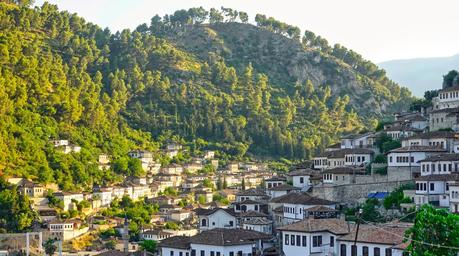
Albanians can take a joke.
Not so long ago, Albania's tourist board developed a marketing campaign designed to poke fun at the country's unwarranted reputation as a safe haven for international criminal gangs. Taken, 2008's hit movie starring ex-versatile actor and current one-trick-pony Liam Neeson, is about an ex-CIA officer whose daughter is kidnapped by Albanian human traffickers.
The movie was a huge success, but it depicted Albania as a dangerous place. And that makes Be Taken By Albania, a brave choice of tourism marketing slogan. And the way I see it, with a little tongue-in-cheek marketing, they used humour to turn a negative into a positive.
In sharp contrast to how the government of Kazakhstan received the Borat movies, the Albanian government saw the positive aspects and even made light of the situation. "Be Taken By Albania" was an attempt to grab attention. And in many ways, it worked.
Not everyone was impressed, however. Taken by Albania was dubbed the world's worst tourism slogan by the Telegraph newspaper, reflecting the UK broadsheet's humour deficit more than anything else.
I'm no expert, but I can imagine that it's hard to measure the impact of a marketing campaign that refers to kidnapping.
For better or worse, attentions were grabbed, and the slogan probably generated more publicity for Albania than anything since (certainly better than "Visit Albania") the ousting of communist party in 1992. And as Donald Trump and Elon Musk know well, getting attention matters, even if it means behaving like a clown.
That's not to say that the tourism board behaved badly. Clearly, they recognized an opportunity and went for it. I applaud the government for creating a witty marketing jingle. Unfortunately, the campaign launched in the year before a pandemic shut the entire world down, just as Albania was welcoming more visitors than ever before.
Tourism numbers hit 6.4 million in 2019 and will probably surpass that in the next few years. In 2023 and beyond, Albania has put high-end ecotourism center-stage and hopes to lure visitors to its (relatively) unspoiled beauty.
In case you're wondering, the likelihood of getting kidnapped is pretty low.
According to Numbeo's database, Albania ranks 65th on their crowdsourced crime index (1 being the country with the highest crime level and 142 being the lowest). In comparison, the country has a slightly higher crime rate than Barbados but does better than Greece, the United States, France, and Sweden). The United Kingdom is only a few places down from Albania.
Ironically, the Global Economy website lists kidnapping rates per country and puts Albania as a less likely place for abduction than Ireland, Belgium, the UAE, and many more. If you consider the other countries mentioned here to be safe, you'll be fine travelling in this Balkan beauty of a country. Solo female travelers shouldn't have to worry about traveling in Albania. Petty crime occurs, but it also occurs in almost every other country in the world.
So let yourself "be taken by Albania". There's a lot to like. #visitalbania
You don't have to be an adventurous traveller to visit Albania: official name Republika e Shqipërisë. Few places are off limits here and the people are open-minded and welcoming. The days of North Korea-style government controls are long gone. It's one of the best places in Europe to experience Europe without the enormous bill.
In the travel section of your bookstore (a good one, if it still stocks travel books), the 'A' section usually starts with Australia or Austria. Argentina might get a look. Afghanistan, hardly. But poor old Albania is buried at the back of guides to Southeast Europe.

Brief history of Albania: a modern country with traditional values
Albania is a predominantly Muslim society with a moderate religious culture. While it's not a tourist destination for religious travelers, Albania has played a small but important part in the history of Christianity and Islam in Europe.
It's a multi-faith country with just over half the population following a Muslim tradition. 10% of people are Catholic and there's a sizeable Orthodox group. Mosques (and churches) dot the landscape, but the burqa and hijab are a rare sight. Many Muslims eat pork and drink alcohol. And everyone gets along fine.
Romans, Ottoman Turks, Serbs, and Greeks have all had their time ruling Albania or have at least claimed parts of it. Visigoths, Huns, Ostrogoths (Eastern Goths), and Slavs came and invaded in the 5th and 6th centuries. The Ottomans ruled for the longest time and it wasn't until 1912 that the Albanian people were once again independent people. The excellently named King Zog, became prime minister in 1922. Not satisfied with that, he took the president's job. Finally, he went all in and became King, his rule lasting until 1939 when the Italian's decided to invade.
The period from 1944 until 1991 is the most peculiar. Communist rule, enforced by the dictator Enver Hoxha, kept the country isolated from the rest of the world. Private cars were banned, not because Hoxha was a forward-thinking fan of sustainabiliy, but because he wanted to consolidate his power and control over the population. The ban was not lifted until 1992.
The centre of Tirana was off-limits to non-Communist party members. This part of town is ironically now packed with hipster cafes and tourist bars).
Hoxha was clearly paranoid, but he was an astute politician and master manipulator. Even now, many Albanians, like many of their neighbours in the former Yugoslavia, pine for the old days. Some older Albanians feel that the country has lost its way.
A survey as recent as 2016, conducted as part of an OSCE Presence in Albania's project to encourage a national dialogue about Albania's totalitarian past, found "a remarkable divide among respondents regarding their perception of Enver Hoxha's role in the history of Albania, which is seen as positive by almost half of the population, and negative by the other half."
A thousand people, whose ages ranged from late teens to over 55, interviewed face-to-face for the survey, were divided on the country's communist past. The results showed that almost half the Albanians surveyed felt that communism was "a good idea, poorly implemented".
Young people today are less likely to understand communism's role in everyday life. At the same time, they have a less rosy view of Hoxha's regime than older people. In contrast, older people, who have firsthand experience of the dictatorship, have a more positive view of it.
I wonder if time really is the healer, or do older Albanians view the past through so-called rose-tinted glasses? There is no doubt that the pace of modern life can be overwhelming to those used to a simpler life, a life spent engaging with real people rather than technology.
Hoxha boasted how he guided the country and ensured it was never subordinated to Western democratic values. He showed a deep hatred for religion, creating the first atheist country, but also one of the most isolated countries in history. The regime persecuted artists, religious people, and intellectuals from 1942 until some years after Hoxha's death in 1985. The communist party was so strong under his leadership that it continued its dominance of politics and public life until 1992.
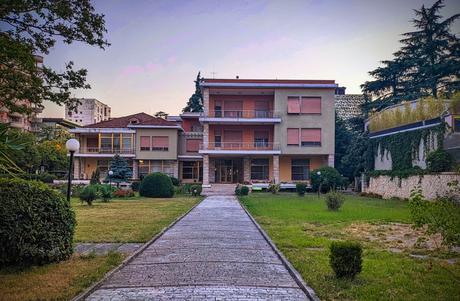
I first noticed Albania as an actual country, rather than just a name on a map, in 1994. I was in Greece living the backpacker life: hanging around, doing odd jobs, looking for adventure, and trying to live as cheaply as possible. Albania was, to me, the tiny country to the north of Greece that was scary and weirdly fascinating. Greeks warned me not to go there.
From what I understood (there was no website to check for latest tourism information), the country was still mostly closed to foreigners. Albania was the kind of place one would smuggle oneself into, while avoiding kidnapping.
Nevertheless, I had heard that tourists were rare, so maybe they would treat me as an alien or foreign dignitary.
It sounded like fun.
Communism had effectively ended in Albania two years earlier and was only a decade without dictator Enver Hoxha, who controlled, tortured, and murdered his own people for over 40 years.
In the excellent book, Modern Albania: From Dictatorship to Democracy, Fred C. Abrahams describes how US and European governments were truly clueless as to what was going on inside this closed-off country. The politics were a secret; the history locked up forever.
Albania Now
I remember passing along the Albanian coast on a ferry from Greece to Italy and marveling at how wild it all seemed. There was little development and few people around. I'd just spent the summer on the busy beaches of Greece, and Albania seemed like another world. The country was just emerging from another era. Even now, south of Sarandë, the coastline is untamed, with little visible development.
Albania might feel like a long way away from Europe but it's close to some of Europe's biggest cities by air (90 minutes to Rome and 60 minutes to Athens). But as Tim Marshall explains in his book, Prisoners of Geography, it's the landscape and the position on the world map that determines a country's fortunes. The mountainous terrain of Albania and its proximity to the former Yugoslavia probably hindered its development while also protecting it from complete control.
Italian fascists ruled the country from 1939 to 1943 but these days, Italian tourists make the short flights or ferry journey to spend their Euros on this, much cheaper, side of the Adriatic.
Albania is, as far as I know, the only place in the world where you'll find a statue of George W Bush. Bush was, and probably still is, popular here.
In Fushë-Krujë, just north of Tirana, an almost 10-foot tall statue of the 43rd president waves at passersby. I can imagine Mr Bush saying, "I just want you to know that, when we talk about war, we're really talking about peace", as he asks one of his aids to remind him which country he's currently in.
Fushë-Krujë is close to the town and municipality of Kruje, where you'll find the Castle of Kruja. This is a popular destination not only for the magnificent castle but also for the historical significance and the Skanderbeg Museum, one of the most visited museums in the country (along with the Natural History Museum).
Fushë-Krujë is where Skanderbeg, an important figure in Albanian history, rebelled against the ruling Ottomans. He ultimately failed, but his brave attempt lives on in legend.
Skanderbeg, who referred to himself as "Lord of Albania", abandoned Islam after spending 20 years in the service of the Sultan in Istanbul. He then converted back to Christianity and persecuted Muslims who didn't convert as well.
The irony is that while Skanderbeg was an astute military commander who fought against the occupying Ottomans, he subsequently slaughtered followers of the Muslim faith.
By 1912, Albania became the last country to declare independence from the Ottomans. But after more than 500 years of occupation, the Ottomans have left many cultural imprints in the food, language, music, and in the religious beliefs of modern Albanians.
A small country like Albania, with its unique culture, could easily have been absorbed into the growing empires of neighbouring Greek and Slavic states. In many ways, the Ottomans protected Albania from assimilation and helped preserve Albania's traditions and culture.
In neighbouring Kosovo, an ethnically Albanian region, stands a three metre-tall statue of Bill Clinton. Clinton was American president when NATO bombed the Federal Republic of Yugoslavia (basically the government of Serbia at the time) in 1999, effectively saving Albanian Kosovars from ethnic cleansing and losing autonomy in their country.
Albania shares a border with Kosovo, and land-locked Kosovars head to their neighbour's beaches to cool off or bake in the sun. Often touted as a cheaper Greece or Croatia, Albania's magnificent beaches are a draw mainly for Kosovars, Croatians, and Greeks. But the rest of Europe and the world is starting to discover the delights of this beautiful country.
In the summer of 2022, TikTok reported that Albania, and in particular, Albanian beaches, were trending on the platform. These golden Adriatic beaches have attracted influencers looking for less crowded and less expensive alternatives to the beaches of Greece and Croatia. Summer post-pandemic in Europe was expensive and overcrowded. Once pandemic restrictions lifted all over Europe, the familiar Southern European travel destinations of Greece, Italy, and Spain were inundated with visitors. Revenge travel was in full swing and people were spending money like they'd been locked up for years, which, in fact, they had been.
Albania offered some respite from the crowds.
The low cost of living and favourable exchange rate has also made the country attractive to bargain hunters. Whenver you get a country with decent infrastructure and a low cost of living, digital nomads and remote workers start to notice. With a stronger foreign currency, Dollars and Euros go further.
While post-pandemic prices in all the popular European "safe" spots rocketed, travellers with more modest budgets looked for an alternative. They found it on the beautiful beaches of Albania.
Less discussed on social media was the interior of the country. Although these places, with temperatures hitting 40 C every day and far from the cooling sea, are not as attractive to visitors in summer.
Sarandë (Saranda)
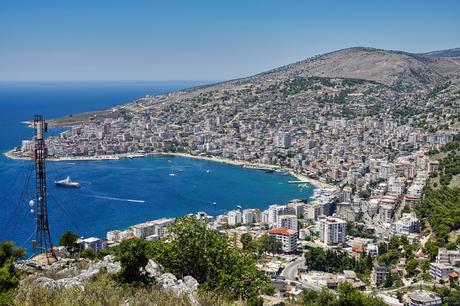
Search for "Albanian beaches" online and you'll find images of stunning shorelines that could pass for the Seychelles, Barbados, or Thailand. Sarandë is ground zero for a beach holiday in Albania.
It's been called picturesque, and in some lights, and with the right camera angle, it could be. I hate to start on a bad note, but it's more true to say that Sarandë is an Instagram-filtered, skin-deep mediocrity. This town lacks any sense of identity and it's kind of a mess.
In his book, Adriatic: A Concert of Civilizations at the End of the Modern Age, Robert Kaplan calls Sarandë a "cancer of cement." He doesn't stop there: "Nowhere in the developing world have I witnessed such a lack of government planning and unchecked construction. There is a quality of barbarism about it that goes beyond aesthetics".
This over-hyped and underwhelming "Saint-Tropez" of the Albanian Riviera has the nightlife and the buzz, but none of the human factor and little of the charm of, say, Corfu town just across the water. Sarandë's city beaches won't win any beauty contests either.
Summer in Sarandë is busy, hot, and expensive by Albanian standards. Hotels charge in Euros, so remember that when you use your credit card, you're paying extra fees. That's if you can even use your card. In Albania, small businesses still rely on cash for transactions, a form of tax evasion that drags economic growth down in a country making great strides in modernization but is still doing the developing world shuffle on tax evasion.
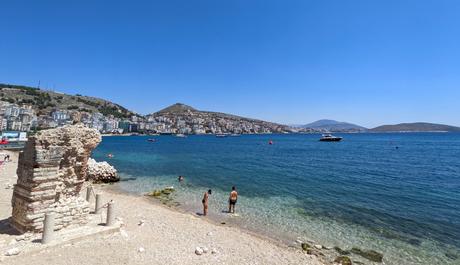
Worth a visit is Kalaja e Lëkurësit (Lekuresi Castle), hilltop castle ruins with impressive views of the city, a large stretch of the Ionian coast, and nearby Corfu. Built in the 16th century by Sultan Suleiman the Magnificent, the castle was used as a defence against the Venetians who ruled the Ionian islands for 400 years.
Compared to neighbouring Greece, a short ferry ride away, restaurants in Saranda are incredibly cheap. Haxhi restaurant, which sits on the waterfront, is warm and quirky, and has a great view of the water. The service is friendly, the decor eccentric, and the food excellent. Note that Albanian wine is a real treat and very reasonably priced, even in popular restaurants like this one.
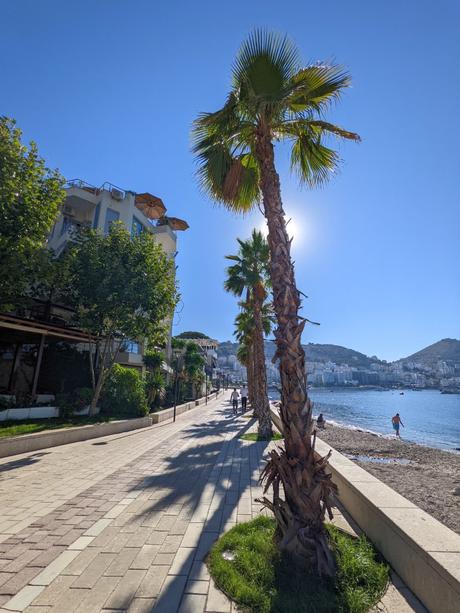
Sarandë's best beaches are outside the city. Ksamil Beach (Plazhi Ksamilit) sits just across the water from the island of Corfu and just north or one of the most important archeological sites in the country, Butrint. It's a beautiful place. The fact that it's hard to reach merely adds to the appeal. But it's become a popular place for crowds of people trying to avoid, well, crowds of people. Ksamil's popularity is turning it into just another beach, much like the ugly ones that sit in front of Sarandë, and in some ways, Vlorë.
Vlorë (Vlora)

Don't snooze on the drive from Sarandë to Vlorë. The scenery is outstanding. If you're taking a bus, prepare for a long ride, but the views should keep you entertained.
Even a few kilometres from the Albania Riviera coast, the country's interior is wild and unspoiled, with immense mountains and valleys draped in trees. There's so much natural beauty here and it's unlike anywhere else I've been. This is a mountainous country with 75% of the landmass over 200m in elevation and you're never far from the Albanian Alps.
Hire a guide if you plan to explore these valleys and the Albanian Alps mountain passes with their ancient trails. Hiking along in these wilder parts of Europe is less feasible than hiking in Switzerland or France, for example. Valleys in some parts remind me of Southeast Asia, with their towering forest-covered mountains and natural terraces.
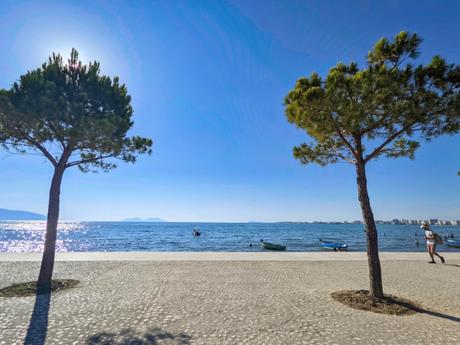
I took a shine to Vlorë. After soulless Sarandë, Vlorë feels like a town with a pulse. It has the trappings of a place where people live rather than somewhere to pose and drink bad cocktails. Vlorë is a prosperous town with a high standard of living.
There has been a settlement in one form or another here for around 2500 years. It was originally a Greek colony and was an important port in the Roman Empire. The port was also used as a submarine base for the Soviet Union during Albania's communist era.
A few steps away from the main shopping thoroughfare, I found a pokey traditional restaurant and ordered roast goat.
I asked the restaurant owner about living in the city. He told me that for €150 a month, I could get an apartment near the city centre.
This might seem cheap compared to Western European prices but the minimum wage here has just recently been increased to around €300 a month, making it one of the lowest wages in Europe. Albania has expressed interest in joining the EU, so if that goes ahead, prices will inevitably rise. But there's a lot of work to be done before that happens. If you're looking for a cheap place to hang out for a few months or even years, this is one of the least expensive parts of the entire continent. Especially when you consider you can rent an apartment in a major city, close to the beach, for less than a room in most other European cities.
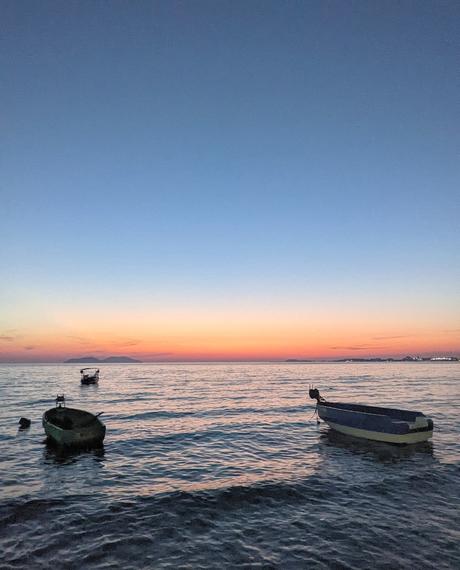
From Bulevardi Ismail Qemali, the main shopping and commercial area, heading west towards the old town, you'll pass by the small, but beautiful Muradie Mosque, one of the few sites to have survived Hoxha's ban on religious buildings.
Next, the Independence monument celebrates Albania's independence from the Ottoman Empire. Albanian independence was declared in Vlorë in 1912, the only town in the entire country controlled by nationalists.
Old Town is a glorified name for a colorful street with added entertainment offshoots. It's a pleasant place to spend an afternoon or evening. Art shops, cafes, and bars have taken over the former dwellings and turned the place into a place to meet and enjoy the simple pleasures of hanging out with friends, something the Albanian people seem to have mastered.
To the east of the old town is the bus station for travel towards Tirana and the north. To the west, fairly close to the old town and running parallel to Bulevardi Ismail Qemali, are the beginnings of the Ceraunian Mountains, hills that offer urban-style hiking and views of the city.
A waterfront promenade of almost 5km divides the city from the beach. At all times of day, you'll find locals walking, biking, and running along the walkway. The many bars and restaurants along the promenade south of the city centre always seem to be busy.
Tirana (Tiranë)
The beaches of Albania get a lot of attention, but for me, the country's most appealing spots lie inland.
Tirana is one of the quirkiest capital cities in Europe. The inhabitants of Tirana seem to have their own secrets, their own ways of doing things, their customs and codes, and we tourists are not privy to them. It makes the place even more intriguing.
The city has a certain Budapest or Sofia feel to it in some parts. There are also places where it resembles a small Turkish city.
The vast city park is a fantastic space to exercise or just hang out with friends. Running, cycling, and walking paths follow the contours of the lake. Resist the temptation to jump in, however! Unless you're blessed with a bulletproof immune system, or you're a researcher for water-borne diseases, best to stay on dry land.
An enormous statue of Skanderbeg, in the eponymous square right in the centre of Tirana, depicts Albania's most famous hero on horseback. Right across the large square is the Ethem Bay Mosque, the National Opera, the National Library, the Palace of Culture, and many other cultural and administrative buildings. This enormous plaza is often used for concerts and festivals, and it's the centre of Tirana in more ways than one.
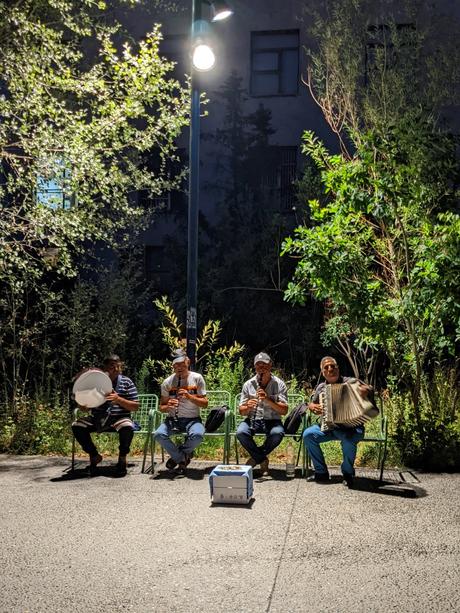
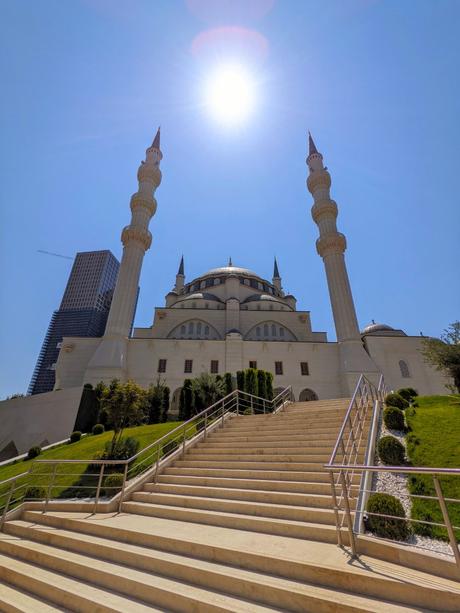
Tirana can be very hot so summer is certainly not the best time to visit. There's a desert-like lack of humidity at this time of year. Even in the shade, wet clothes dry in minutes. After a day spent walking Tirana's grid-patterned streets, it can feel like your tongue has been dragged over sandpaper. Nights are somewhat cooler and mornings can be cool in the low 20s, but that is the only respite.
Drink lots of water, kids!
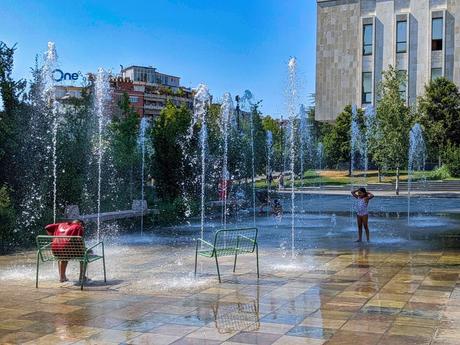
Winter, on the other hand, can be quite humid and there's plenty of rain.
Albania's capital is located centrally in the country, almost equidistant from its northern and southern borders. It's about an hour's drive to the coast from the city centre, and it takes 2 hours to drive to Lake Ohrid on the eastern border.
This is the most important city in the country, but it lacks the depth of historical sites and landmarks found in other Eastern European capitals. Tirana is only 400 years old, brand new by European standards.
If you're looking for ancient ruins, you're in the wrong place. But if you want to see truly weird and unique modern architecture, Tirana has what you want. The capital is currently undergoing a construction boom that will transform it into a modern metropolis. There are plenty of fantastic examples of Modernist architecture here, as well as some incredible communist-era buildings.
Some of the original buildings have been demolished to make way for modern skyscrapers and funky offices.
Compared to Albanian cities like Berat and Gjirokastër, which have that beautiful, fairy-tale, traditional Balkan-style vibe, Tirana feels lacking. But it has its charms.
A visionary mayor of Tirana incentivized local architects and artists to create colourful and outlandish designs. The plan was to not only improve the vista of the city, but also make it a more interesting and unique place to live and visit. The result hasn't been entirely welcomed by residents, but these buildings certainly draw attention.
Other notable constructions include the TID building, the Rainbow building, the ABA Business Center, and the 4-ever Green building.
Dotted around the place are several large murals, graffiti works, and street art creations that add some character.
Multi-story office towers aren't the only quirky structures in Tirana. A few bars in Tirana are masterpieces in their own right. Night owls and fans of aesthetically pleasing drinking establishments should check out Radio Bar, Hemingway Bar, and Nouvelle Vague.
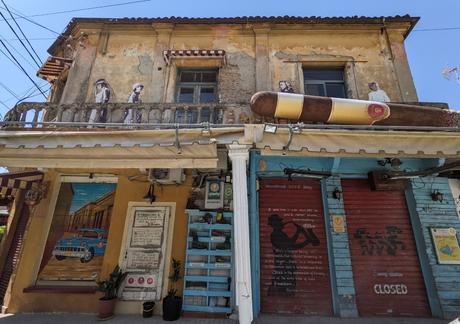
Start in Skanderbeg Square and head out in all directions. Rolf Potts' advice to "walk until your day becomes interesting" is worth following here.
One of the most bizarre examples of Tirana's modern architecture, known as the Pyramid, is currently under renovation, and there are big plans to turn it into a recreational space. It was originally built as a memorial to Enver Hoxha and later used as a NATO base during the Yugoslavian wars of the 90s. Now it's being transformed from an urban decay photo opportunity to an Instagram attraction for fans of the 'like'.
Try a walking tour of Tirana that focuses on the communist era for an insider's guide to the fascinating Bunkart, Enver Hoxha's house, and the House of Leaves Museum.
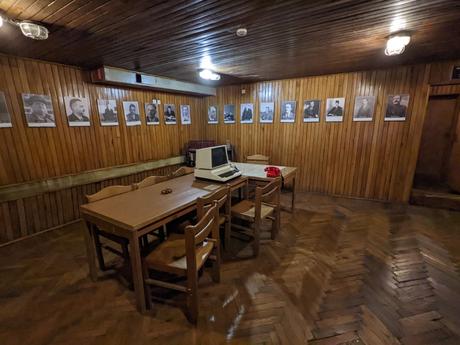
Walking around some of the trendy areas of Tirana like Blloku, it's hard to imagine that the average wage is still around $500 a month. It's not hard to find upmarket and boutique clothes shops, expensive restaurants, and luxury condos with flashy cars parked outside. There are plenty of places to enjoy meals that cost as much as they would in Paris or Berlin. Even supermarket prices seem a little on the steep side, especially for certain niche products. Who in Tirana buys tiny $60 tubs of Manuka honey? (pure marketing-hype, by the way)
Albania has the fourth lowest average wage in Europe and the fourth lowest in GDP per capita, out of 48 countries.
ATMs are generally out of service all the time, every day, all over the capital so take cash out before you need it.
Berat
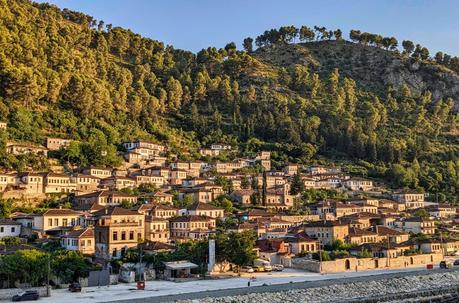
The gorgeous Ottoman town of Berat - city of a thousand windows, is a stunning valley settlement nestled around the river Osum, and known for its distinctive architecture, is one of the highlights of a visit to Albania.
It is also one of the most unique cities in all of Europe. The Old Town, a UNESCO World Heritage Site, has narrow cobbled streets and buildings from the Ottoman era that is still standing today.
It's easy to feel relaxed in this town (I certainly did), where Muslim and Christian locals live side by side in harmonious cohabitation. Pope Francis praised the country as a example of religious tolerance. The residents are laid back and welcoming.

Besides the rich history, delicious foods and jaw-dropping scenery, Berat is also a superb base for hiking enthusiast. After you've eaten your weight in byrek, tava e kosit, and Berati steak (a meat and cheese dish that will make you reconsider any thoughts of leaving Albania), a bit of exercise will help prevent the wheels from seizing up.
The food is wonderful and cheap, even in the higher end restaurants, of which there are many. Try the Berati steak in Friendly House where you can enjoy the lovely traditional interior or the rooftop dining area with a fantastic view of the houses across the river. Best spot in town.
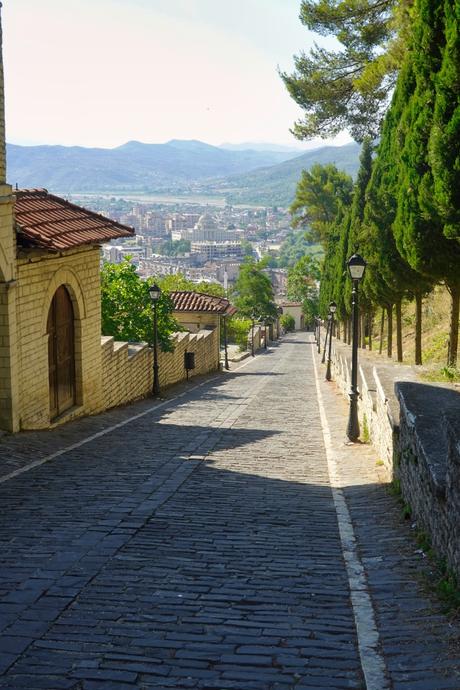
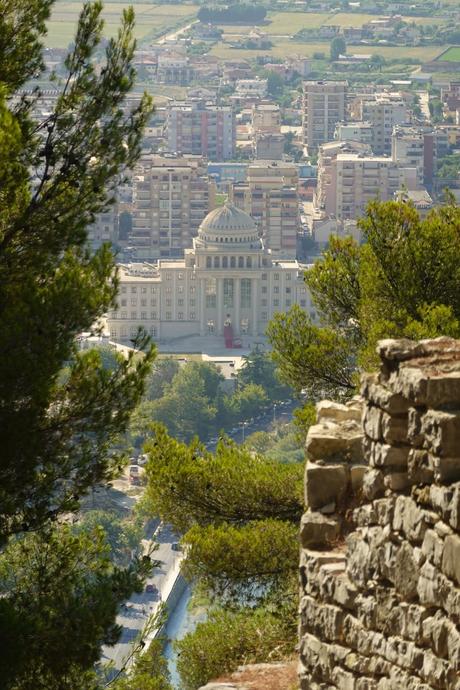
Wherever you decide to eat, try to have a view of the principal streets or boulevards. Or sit outside a cafe with a post-meal drink or coffee and watch people do the Xhiro tradition. Xhiro is an Albanian word which means something like "going for a stroll in the evening with family and friends, alongside everyone else in the town after the sun sets".
Xhiro sounds like 'giro' in Italian (and Spanish) from the world girare, means to move or go round. Giro is also used to describe a tour. The etymology of the word was hard to track down, but 'tour' seems to be a good translation.
Daytime temperatures reach boiling point here thanks to the wind-breaker mountains, the altitude, and the inland location, far from any cooling sea breezes. In the hottest months, only tourists venture out between noon and sundown.
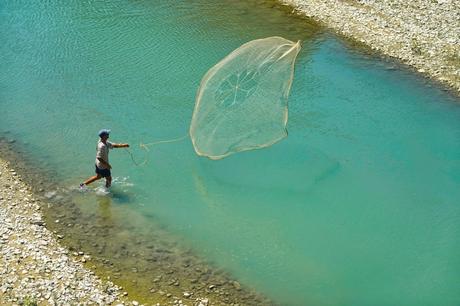
Lake Ohrid
In the east of the country is lake Ohrid, which straddles the border of Albania and North Macedonia. While there are small towns on the Albanian side, the main attraction on the lake is the town of Ohrid, just a 20-30 minute drive from the border and definitely worth more than a day trip. A UNESCO World Heritage Site, Ohrid is a major summer draw for Macedonians and people from all over the Balkans.
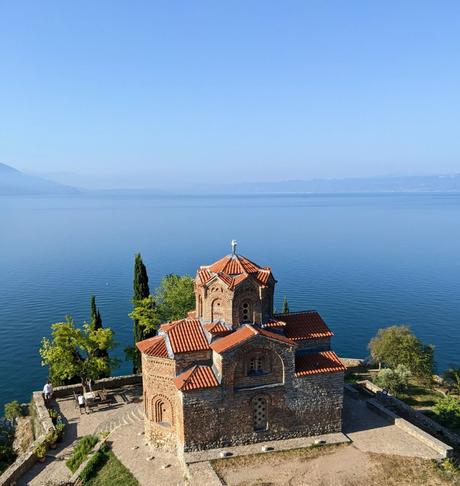
The Albanian countryside bordering Lake Ohrid also hosts the beautiful Shebenik Jabllanice National Park, a zone of glacial lakes, high peaks, and wildlife rare in other parts of the Balkans.
Food & Wine
Albanian food is a mix of Turkish, Greek, Italian, and many other cultures that the Albanians and the diaspora have borrowed, stolen, and assimilated.
I'll have to trot out the old cliché about how fresh the ingredients are in traditional dishes in Albania. The dishes have uncomplicated and balanced flavours. Albanian food is mostly fresh, generally simple, and always satisfying. Traditional local food should always be your first choice.
Try a variety of different dishes to experience the full range of flavours in Albanian cuisine. You'll feel like you've been transported back in time to when food was actually good, when it was sourced locally and eaten seasonally.
Pork is available in most places, especially large cities, but meat appears a lot less on menus than in neighbouring Greece. Notably, Albania has one of the lowest rates of consumption of meat in Europe.
Italian restaurants are all the rage in the trendy parts of the bigger cities like Tirana (around the Blokku area) and the tourist towns of the coast. Unfortuantely, Tirana's trendy restaurants seem to have turned their back on the food that the rest of the country enjoys. Locals told me that the best meals in Tirana are found on the outskirts of the city.
The capital's wine stores prefer not to stock local wine, another peculiarity that seems to be based on some kind of big city snobbish distaste for the homegrown. Wine stores, at least in the central areas of the city, might stock only a couple of bottles of Albanian wine. The rest of the bottles are Italian (mostly), French, and Spanish imports. It's almost impossible to find anything else: Argentinian, Australian, Californian, Georgian? You're out of luck.
Many Albanians produce their own wine in home gardens and allotments, like they do in Georgia and Bulgaria. And this is often the best wine you'll taste in the country.
I casually mentioned my frustration with sourcing local wines in the capital to my apartment host. A half hour later, his mother appeared carrying a 1.5 litre plastic soft drink bottle filled with 3-month-old refrigerated wine, made from grapes from their backyard vineyard. It was surprisingly delicious.
Coffee shops are everywhere and it's impossible not to notice them. Much of Albanian life takes place here. In the more traditional places, most customers are men who sit for hours drinking coffee, ensuring that Mediterranean lifestyle stereotypes are in no danger of being challenged.
Specialty coffee lovers will be underwhelmed by the brew in most casual cafes. Luckily, there are a few independent and chain coffee shops around that are comfortable, welcoming to all genders, and serve decent specialty coffee.
Dhallë is quite popular and you'll find it in most supermarkets and grocery stores. It's a unique fermented milk drink from Albania, made by combining cow, goat, or sheep milk with a special culture of bacteria and yeast.
The Albanians
Modern Albanians are among Europe's most homogenous populations. With thousands of years of history in the Balkans, Albanians can be traced back to ancient Illyrians and Thracians, with a minority being Slavic in heritage.
A 2011 census (considered somewhat unreliable by the Council of Europe) states that almost 96% of the population identified ethnically as Albanian. The true number is somewhere over 90%. The most significant minority groups are Macedonians, Romani, Greeks, and Montenegrins.
As a result of their isolation, Albanians have a distinct culture and language, unlike anything else in Europe. Given the country's troubled history, its people are very protective of their nationality and culture. The Albanian language is the only official language in the country, but most people speak English or another second language.
The people are friendly and curious, and like in many Eastern and Southeastern European cultures, there's a hard exterior protecting a soft interior. Get to know them, and you'll find a warm, family-oriented people with a sense of humor.
As in Bulgaria, nodding indicates no, while shaking the head indicates yes. This obviously creates confusion for non-Albanians, especially when outsiders try to second guess it. Are they nodding because they know you're a foreigner who expects a nod to mean yes? Or are they nodding because they're Albanian and that's how it's done here?
If in doubt, ask.
The word for yes in Albanian is po. The word for no is jo (the j is pronounced like a hard h).
Highly animated conversations on the street might appear to be conflict, but they're probably discussing the weather. Some cheek kissing, caressing, smiling, frowning, hand waving. Then off again with a smile.
Many people smoke, and you'll be exposed to secondhand smoke in many public places. Don't expect a smoke-free restaurant or cafe experience. There are no EU-type regulations on smoking indoors and it's hard to imagine people would welcome those laws either. While it's not as bad as Georgia (few places are), most people love a cigarette, so for nonsmokers it can be an uncomfortable country to visit.
Despite smoking's negative effects, Albanians live just about as long as their European counterparts. Albanians are certainly doing better than most of their Balkan neighbours in terms of lifespan.
Travelers should be ware that Albanians have a casual relationship with deadlines. Taxi drivers are just as bad here as pretty much everywhere else (Portugal seems to break that rule for some reason) so be prepared for some extra-curricular downtime.
Getting around
It is a common stereotype that Southern Europeans drive poorly, so I was expecting some near-death experiences. Don't forget that many current car owners lived during a four-decade period where cars were banned. "Out of practice" is the phrase that springs to mind. However, the driving was fairly measured. In contrast to Turkey, a Formula One training ground, Albanians are not in a hurry to meet their maker.
Slow driving is the norm for buses. Bus travel is cheap (1990s Southeast Asia cheap) and is often the only means of transportation. For long journeys, expect to pay less than $5 for journeys of 100-200km. Just don't expect to get anywhere fast. What looks like a 2 hour journey might take 5. That's just how it is.
Internal flights are non-existent and, thanks to several years of pandemic, there are fewer rental cars than before. Most tourists opt for the buses. Some, like the ones that travel between Tirana and Macedonia, have air conditioning. Others, like the ones between Sarandë and Vlorë, are sweatboxes with wheels.
It is still common for Albanian businesses to accept cash rather than credit cards - only some supermarkets and high-end hotels accept them. Cash machines dispense high denomination notes, which smaller businesses refuse to accept.
In any case, a trip to Albania won't break the bank. It costs nothing to stroll around Tirana admiring the unusual architecture and soaking in the unique vibe. For the most part, hiking in the mountains is free - there are few gatekeepers.
Getting to hard-to-reach places will be your biggest expense. The bus network covers most major towns, but you'll need a taxi or rental car for everything else.
You'll need private transportation to visit those deserted beaches you might have seen in Instagram ads and Albanian tourist board literature. Albania may have beaches to rival Greece and Croatia, but they're often small and hard to reach. During high summer, they are unlikely to be deserted either. Many beaches have umbrellas covering the sand to such an extent that the entire waterfront looks like an undulating marquee.
There isn't much to get excited about at the town beaches, either. You'll need to get out of town if you want to experience the Turquoise water of the Adriatic and the white sandy beaches of the Albanian coast.
Taxi tip: Negotiate a price. When the driver doesn't need to follow the 'official' indicated route, they can take shortcuts. It's a quicker journey and less expensive.
And always remember the travel rules for transport: look scruffy when you take a taxi but look sharp when you get a flight.
Albania's Tourism Industry
Albania has been open to tourism for almost three decades, but it's still an emerging destination. While other Balkan countries flock to Albania's coasts in summer, this little country rarely catches the attention of travellers from Western Europe and North America. Albania jostles for space in the line-up of much bigger players in the tourism space, like Greece, Croatia, and Italy.
Development is happening fast, but not always in a good way. Complaints about noise are increasing. Incidences of pollution and littering on beaches are growing. It is disheartening to see a coastal region that has remained relatively untouched by tourism fall victim to the same problems seen in other, more popular Mediterranean destinations.
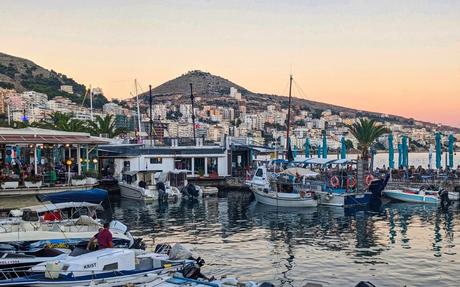
But look beyond the ugly façade of some beaches and you can see a country that has not yet revealed all its secrets to the world. Places like the Church of Saint Mary in Maligrad, a church on a tiny island on a lake in the centre of Albania, are relatively unknown to outsiders. The Rodoni Castle ruins and St. Anthony Church (Kepi i Rodonit) to the north of Durrës are not on the typical tourist trail but worth a day trip. The Shebenik Jabllanice National Park is an accessible but unexplored forest area that adventurous travelers and wildlife fans will love.
Further south are the beautifully preserved, historic towns of Berat and Gjirokastër.
Skodhra in the north is a gateway to the Alps of the Balkans, a hiker's paradise and somewhere you won't find hordes of other tourists.
Even Tirana's unique architectural features are enough reason to spend a day or two wandering around the city.
Despite its diminutive size, Albania has four UNESCO sites, with four more on the tentative list.
